Taking Measure
Just a Standard Blog
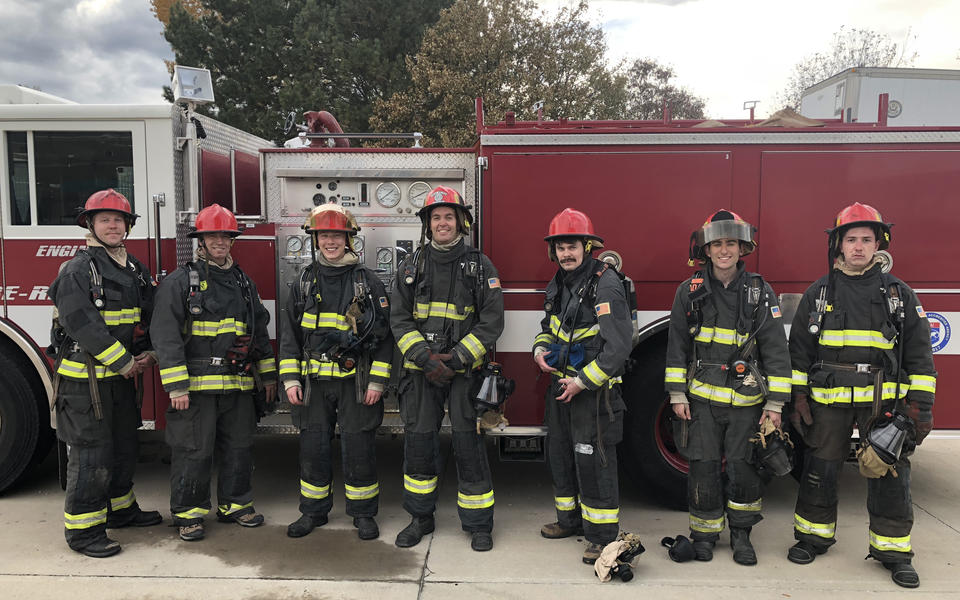
From left: Scott Ledgerwood (that's me!), John Beltz, Jack Lewis, Jeb Benson, Steven Fantaske, Paul Merritt, and Chris Johnson of the NIST Public Safety Communications Research Division in full firefighter regalia wrapping up for the day.
It all started with a conversation at the dinner table with my Uncle Dale. Dale had worked at Boca Raton Fire Rescue for 36 years before retiring as a captain, and I’d been telling him about our recent project using virtual reality to test and develop new user interfaces such as visual aids and audio cues for first responders. I was pretty proud of the virtual environment we had built last year for a prize challenge, which tasked developers to create their ideal user interface—in this case, a heads-up display—that would help firefighters navigate through a burning building. I showed him some images of our fire scene, including the pleasantly bright office space, small plumes of smoke, and little contained fires scattered about the building. To this, he politely responded: “That’s great, but to really understand what a firefighter goes through, you need to strap on some gear and experience a fire firsthand.” Thus began a search that led me to Dean Wahl, director of West Metro Fire Training Center in Lakewood, Colorado.
Suiting Up
Dean put together an all-day course that gave the seven of us from NIST’s Public Safety Communications Research Division (PSCR) the perfect taste of what it is like to be a firefighter. Did I expect we’d be able to hop on a fire engine and extinguish a five-alarm fire the next day? Certainly not. But at least we’d be able to understand basic aspects of the job and experience some of its challenges firsthand. Our day started with a self-contained breathing apparatus (SCBA) mask-fitting to ensure no particulates would sneak through any crevices and into our lungs. Of course, one critical step in obtaining a good seal was shaving off that facial hair we’d been nurturing all fall. Our group, all men in this instance, had to nix everything but a mustache, much to the dismay of our spouses.
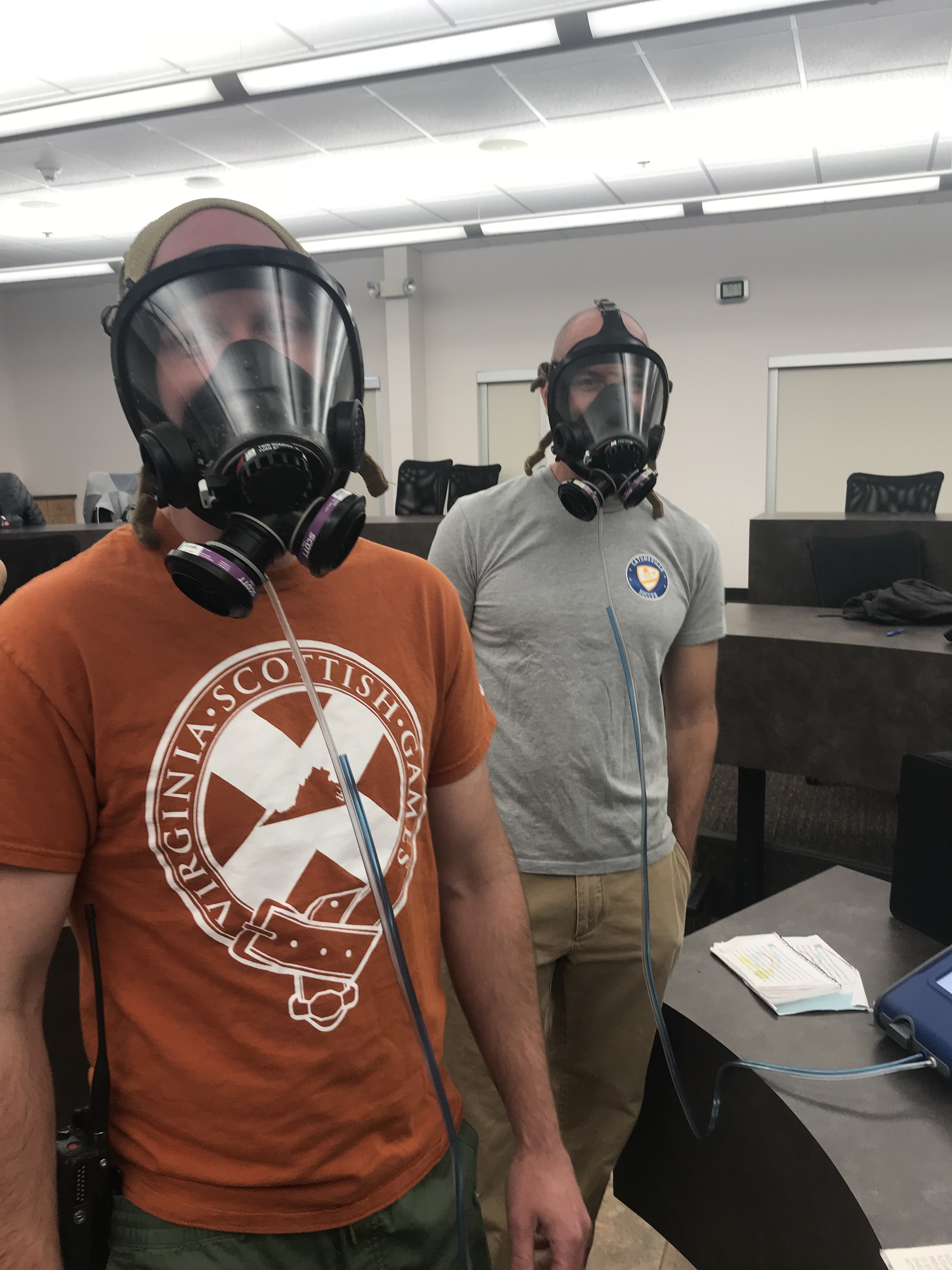
At the next station, we selected our turnout gear for the day—jacket, pants, suspenders (optional), boots, flame hood and gloves. We were given a quick lesson on air tanks and respirators, then grabbed our airpacks to round out the now 22.6 kilograms (50 pounds) of gear. A key piece of equipment was the Personal Alert Safety System (PASS) alarm. This device monitors a firefighter’s movement when the airpack is on and emits a progressively louder chirp if the firefighter stops moving, alerting everyone nearby that they may need assistance. Supplementing the PASS alarm is the firefighter “hip wiggle.” This gentle sway ensures you won’t trigger an alarm and annoy your colleagues because you were standing still too long. We learned that having seven suited-up NISTers chatting in a circle quickly becomes a constant game of nudging, pointing and shouting “shake!” to silence the systems.
Dean and I had spoken a few times before training day, so he knew PSCR had a strong interest in communications and technology. We’d talked about the potential of virtual reality and how it could assess the usability of new technology for first responders in a safe, low-cost manner. It’s a very flexible platform in that it allows us to easily measure the performance of new public safety technology, restart a scenario with the click of a usa-button, and all without the “fire emergency plan” you would need if you actually set a hallway on fire. There’s no question in my mind that virtual reality is an amazing tool for transporting a user to a new world and fully immersing them in that environment. To use it effectively, though, we have to get the virtual scenarios as close to real life as possible.
Our experience at West Metro Fire revealed just how much more work we had left to do.
Learning to Crawl, Walk, Listen, and Talk Like a Firefighter
At the training center, we began by playing the classic game of telephone—where one person takes a phrase and then whispers it to the next person in line—to show how difficult it can be to communicate with turnout gear on. The game continues until you reach the last person in line, who has to repeat the message to the entire group. The whisper turns into shouting when you add an SCBA mask with air respirator, but the results are equally ineffective. What started as “The Queen wears red socks” became “holes in socks.” Close, but not acceptable in a scenario where every word can be critical to the operation—especially when life and injury could be on the line. Dean gave me one of their standard-issue radios to carry around the rest of the day to further assess how well we’d be able to communicate.
The next two drills gave us practice running and laying out hoses at the minuteman station across campus and prying doors open at the forced entry area. This was the first real physical activity of the day, and we quickly felt the weight of the gear. Next, we headed over to the “Maze,” which was both fun and challenging. The Maze, which was built inside a shipping container, required a combination of crawling, hoisting ourselves over, or lying down and pulling ourselves through multiple obstacles meant to simulate real-world operations, including false floors and electrical wiring that easily snagged your airpack. If these obstacles weren’t enough, we had to complete the course blindfolded, which made a few of my team members more than a little claustrophobic. (Note: Disorientation is a major cause of firefighter injury and death.) For the seven of us, consciously working to stay calm and taking frequent breaks ultimately made the uncomfortable obstacle course an awesomely rewarding experience.
Moreover, we were thankful that our instructors kept us well hydrated and that we’d chosen a cool fall day for training.
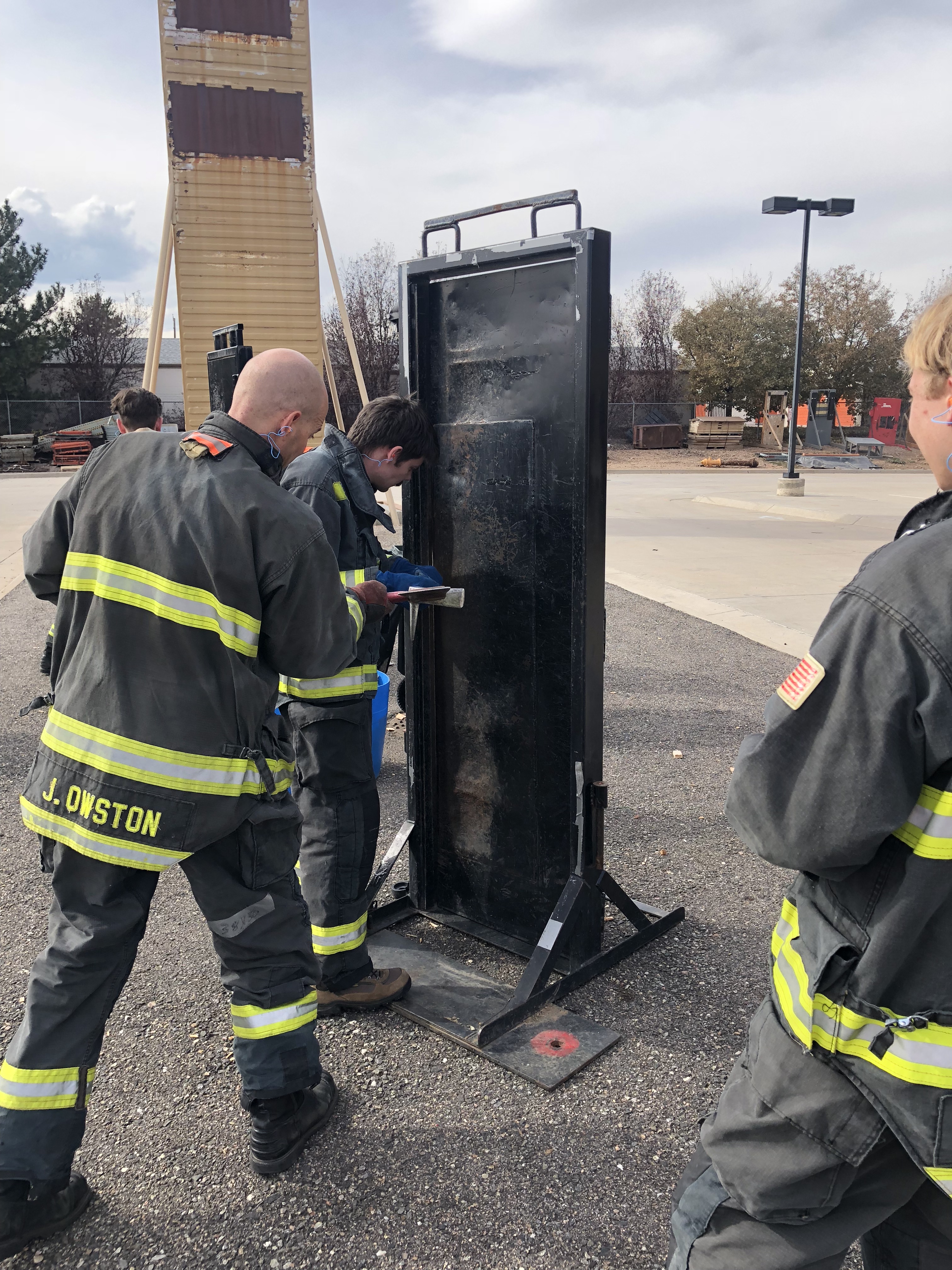
Blinded by Science (and Smoke): An Eye-Opening Discovery
The day reached its climax with the fire attack and search and rescue. Our team was split into two groups: One would find the fire and extinguish it while the other would perform the search and rescue mission. Before we commenced the operation, we did a walk-through of the three-story training residence to get a feel for the layout, something like a firefighters’ preplanning exercise.
My group was first up for fire attack. Our instructors hinted that a fire had been spotted in the basement, so we connected the hose to the fire engine, positioned it in line with the back door, and gave the signal to start the flow of water. With all the excitement, one of us forgot to connect his respirator to the SCBA mask—a dire mistake in a real fire. Luckily, a colleague noticed and was able to grab the person before he ran into the building. Now that we were geared up, we swung open the door, charged down the hall, and made a quick right turn only to run straight into our other team as they were making their way upstairs. Blinded by enthusiasm and smoke, we completely blew by the basement stairwell and found ourselves stuck with a heavy, charged hose that needed to be backed out of the building.
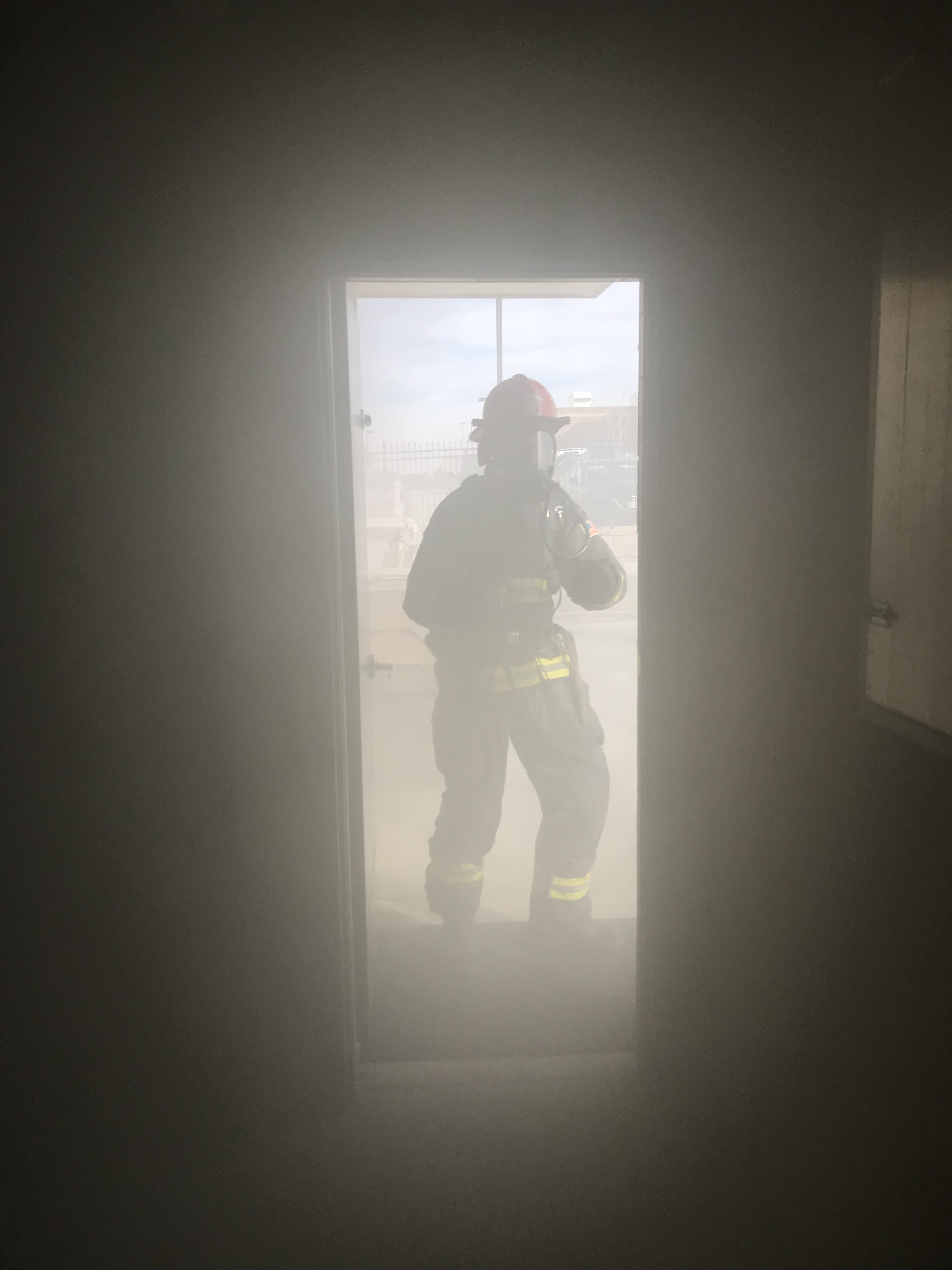
In near-blackout conditions, we clumsily made our way back to the stairwell and slowly descended step-by-step. The lead on the hose line called out, “fire spotted!” and we all braced for him to open the nozzle. When he did, the hose jolted us all backward with a surprising amount of force. We were able to regain control by kneeling over the line and extinguished the fire after a few minutes. I grabbed the radio and informed the incident commander that the fire was out and that we were making our way back up. I then spent what felt like forever fumbling with the radio as I tried to put it back in my front coat pocket. It turns out that firefighter gloves really limit your dexterity, making something as simple as opening a Velcro flap to slide in a radio an impressive feat.
We made our way out of the building and checked in with our other team. They had located one victim and brought them out successfully, but there was still one more inside. Our group headed back in to assist with the search, forming groups of two and making sure to stay together so that no one got lost. As we approached the rooms, we fell to our knees and began feeling along the walls for anything that resembled a victim. How do you know where to look? I kept thinking to myself, how do we know where they already searched? A few times I grabbed a soft object thinking we found our guy only to realize it was a couch cushion. After a few minutes, we finally located our last victim under a kitchen table. I radioed in that we found the victim and were heading out. After we emerged, we all felt immensely proud of ourselves for finishing this task and began recounting our experience and what we had been thinking or attempting to do at each juncture.
Running Short of Breath
During the next round, we switched up the teams and took on the added challenge of completing our search and rescue with a low-air alert. The airpacks we used were 4,500 PSI tanks, or “45-minute tanks.” As we worked through the various tasks we saw our air levels drop from 100 percent to 50 to 25 and below. We were able to monitor our levels by observing the green, amber, and red lights on the heads-up displays inside our facemasks. West County typically keeps a team engaged until their airpacks hit 50 percent. They’ll then start swapping their firefighters out to bring in the next team. For our final drill, our instructors kindly depleted our tanks to below 25 percent, causing our LEDs to change to red and activating the haptic vibrator alert on our masks. Our communication issues grew exponentially as we struggled to hear each other over the incredibly distracting buzzing and chirping of the alarm.
As we completed the second round, I found myself once again rolling over mattresses and sweeping my arms under furniture trying to feel for our victims. The vibration on the mask seemed to numb my senses and slow our progress through the building. We ended up running too low on air and cycled out with our colleagues in hopes they’d make it farther and find the victim. While resting between runs, the instructor handed me my radio, which apparently had fallen out as I was climbing over obstacles. Clearly, I would need a few more training days before I’d be ready for the big leagues.
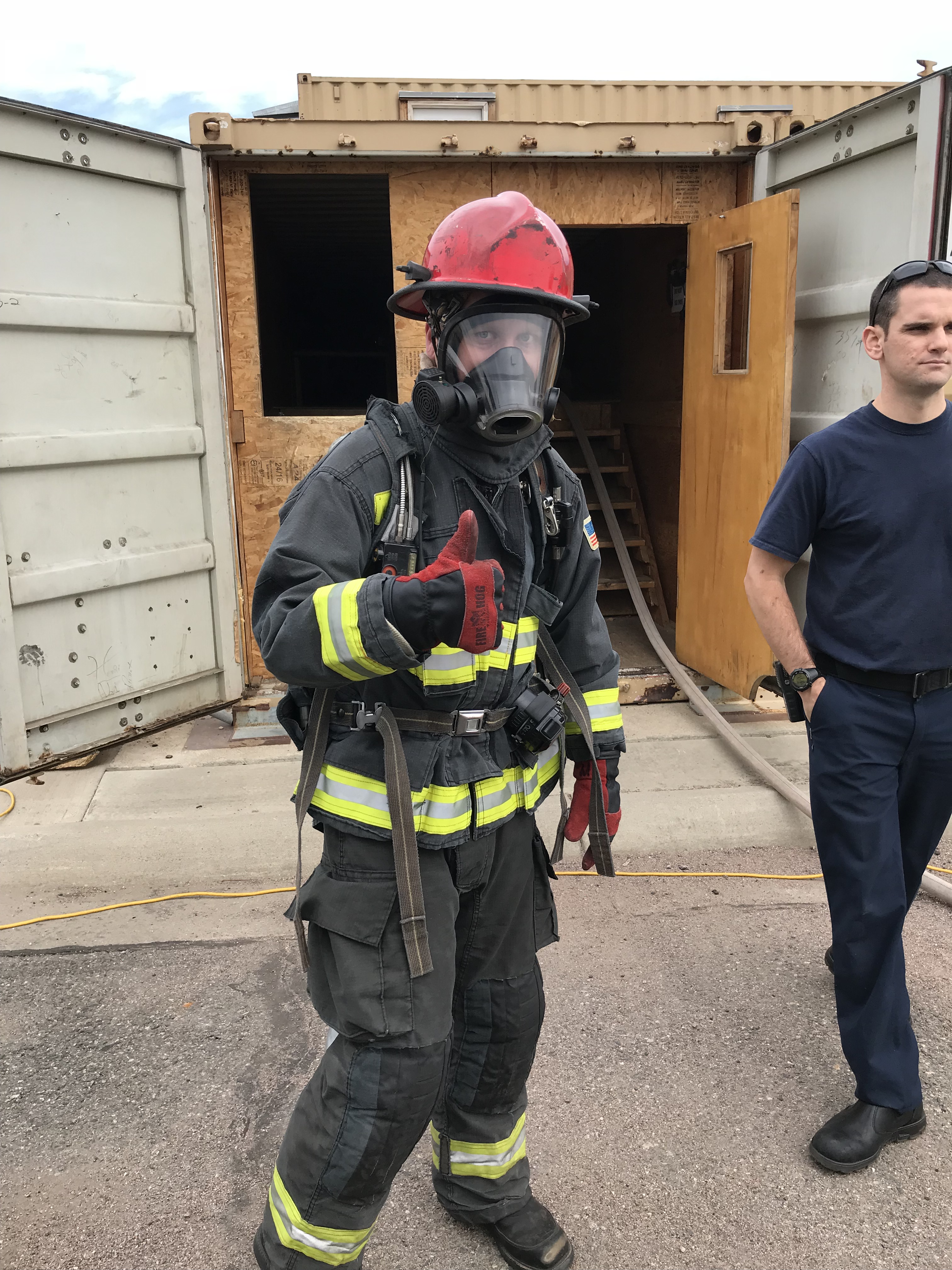
Our third team finally found the victim, and we called it a successful, albeit exhausting, day. As we completed that last challenge, all I could think of was how silly our pristine virtual office fire must look to our firefighter stakeholders. And it made me realize how right my Uncle Dale was. We learned many valuable lessons together throughout the day, which fostered a much stronger bond among our group. We’ve already applied some of the things we learned from West Metro Fire to our virtual reality project. Some initial changes include both auditory and visual improvements. For instance, the smoke will be so opaque you will not be able to see your hand in front of you. In fact, it will extend throughout the office space, as opposed to one small corridor. The bright-lit office space will now rely solely on emergency backup lights since firefighters are likely to cut the power to a building in case the fire is electrical. Our nice crackling fire will now be overtaken by the sounds of respirators, muffled radio traffic, and the occasional PASS alarm. In other words, a firefighter's real reality. We look forward to showing our stakeholders the next phase of our environments.
Toward a More Real Virtual World
I’d like to thank my uncle for encouraging me to seek out some hands-on firefighter training, Dean Wahl and the West Metro Fire Training Center for opening their doors to us and providing us an amazing experience, and for my team’s positive, “go get ‘em” attitude. I’m happy to say that while we made many mistakes during training, we made it out, not just unscathed, but for the better. We remain humbled by the experience, and we’re excited to continue learning and improving upon our work to help keep our brave first responders safer while they’re keeping us safe.






Wow - great write up, Scott! What an incredible experience for all of you and I'm sure the results will show in your work.